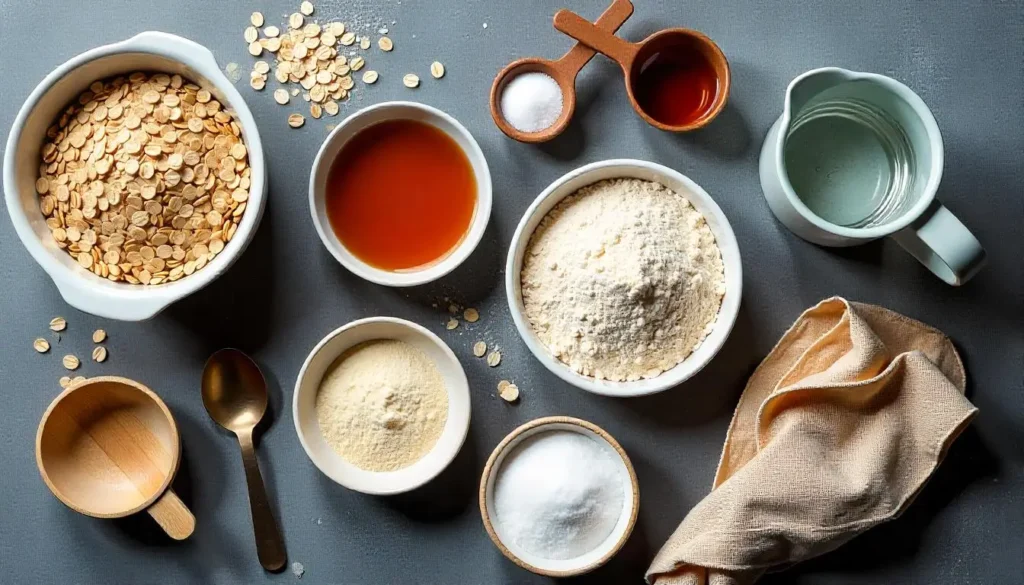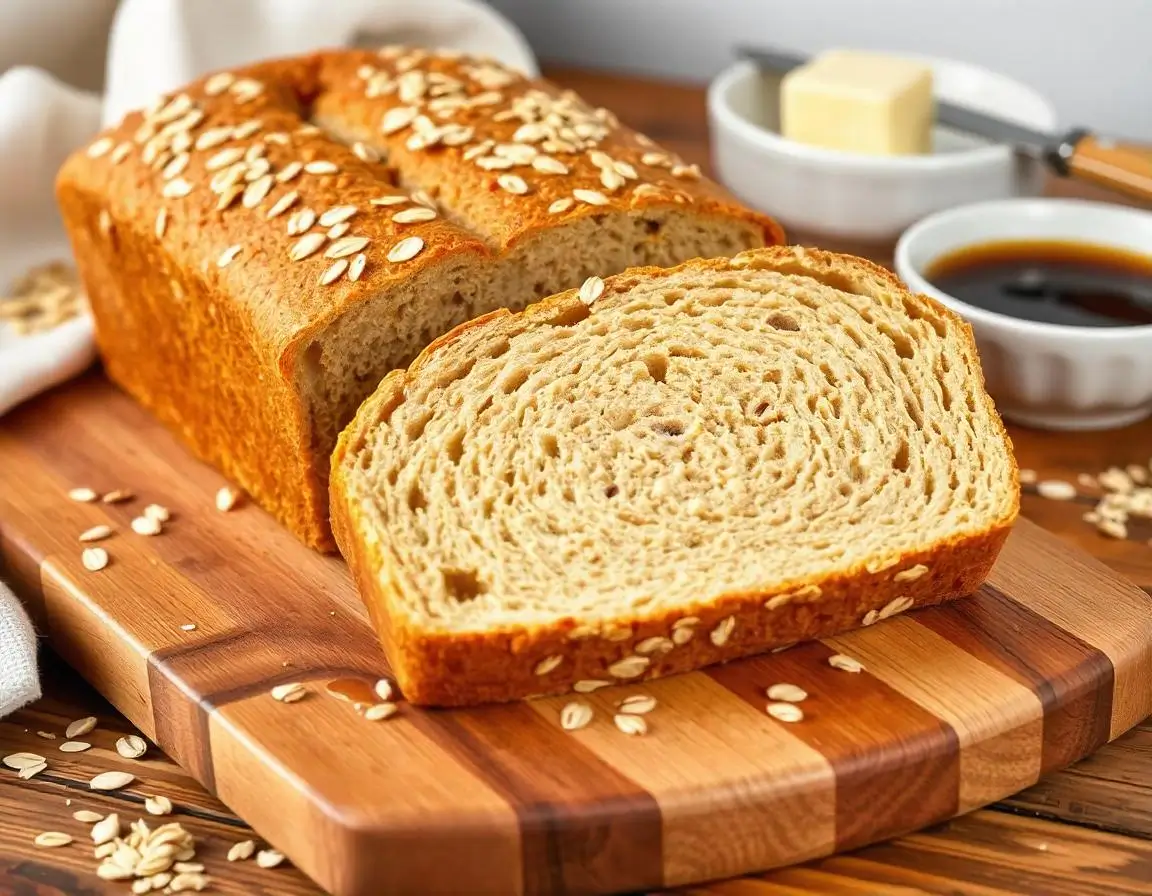Introduction
Oatmeal Molasses Bread might sound sophisticated, but it’s a straightforward, soft, and lightly sweet bread that wins hearts after the first bite. With its warm, rustic charm, the blend of oats and molasses creates a rich, comforting flavor that’s impossible to resist. This recipe is crafted with beginners in mind, offering an easy step-by-step guide to baking bread from scratch. You don’t need prior experience—just follow along, and you’ll have a loaf that smells heavenly and tastes even better. Let’s dive in and fill your kitchen with the irresistible aroma of fresh bread!
Table of Contents of Oatmeal Molasses Bread
- About the Recipe
- Why You’ll Love This Bread
- Key Ingredients and Substitutions
- Step-by-Step Guide
- Expert Tips for Success
- Variations and Customizations
- Nutritional Highlights
- Storage and Reheating Tips
- Recipe Card
- Historical Background
- Nutritional Benefits
- Cultural Variations
- Common Challenges and Troubleshooting
- Serving Suggestions
- FAQs and Comments
About the Oatmeal Molasses Bread Recipe
Baking bread can seem daunting, but this beginner-friendly Oatmeal Molasses Bread is here to change that. The combination of hearty oats and rich molasses creates a flavor profile that’s as welcoming as a cozy hug. This recipe keeps it simple with pantry staples, making it accessible for any home baker. Historically, this bread gained popularity in New England due to the widespread availability of molasses. Its slightly nutty texture and mild sweetness make it a versatile choice for any meal or snack. Even if you’ve never baked before, this foolproof recipe ensures success.
Why You’ll Love This Recipe
- Perfect for first-time bakers with simple instructions.
- Great for sandwiches, snacks, or toasted with butter.
- Made with wholesome, everyday ingredients.
- Soft, fluffy texture with a rich molasses sweetness.
- Fills your home with a delightful bakery aroma.
- Ideal for meal prep or make-ahead baking.
Key Ingredients and Substitutions

- Rolled Oats: Provide a chewy texture. Quick oats can work, but avoid instant oats for this recipe.
- Molasses: Adds a deep sweetness. Swap with honey or maple syrup for a different flavor profile if needed.
- All-Purpose Flour: A reliable base for the bread. Replace up to 1 cup with whole wheat flour for added fiber and a denser texture.
- Yeast: Ensure it’s fresh and active for the best rise.
- Milk: Keeps the bread tender. Substitute with almond, oat, or soy milk if preferred.
- Salt: Essential for balancing the sweetness and enhancing flavor.
How to Make Oatmeal Molasses Bread (Step-by-Step)
- Soak the Oats: Pour boiling water over the oats to soften them. This step is key for achieving a tender crumb.
- Prepare the Wet Ingredients: Combine the softened oats, molasses, milk, and butter in a mixing bowl.
- Incorporate Dry Ingredients: Gradually add the flour, yeast, and salt, stirring until a sticky dough forms.
- Knead the Dough: On a floured surface, knead the dough for about 8-10 minutes until it becomes smooth and elastic.
- Let It Rise: Place the dough in a greased bowl, cover, and let it rise in a warm spot until it doubles in size (1-2 hours).
- Shape the Loaf: Punch down the dough, shape it into a log, and transfer it to a greased bread pan.
- Bake to Perfection: Bake at 375°F for 35-40 minutes. The loaf is ready when it’s golden and sounds hollow when tapped.
Expert Tips for Success
- Always test your yeast before using it to ensure it’s active.
- Soaking the oats is crucial for achieving the right texture.
- Avoid over-kneading; aim for a smooth and elastic dough.
- Allow the bread to cool completely before slicing to maintain its structure.
- If your kitchen is cold, let the dough rise in the oven with the light on.
Variations and Customizations
- Sweet Touch: Add cinnamon and raisins for a comforting twist.
- Savory Flair: Mix in fresh herbs like rosemary or thyme and a hint of garlic powder.
- Crunchy Additions: Include sunflower seeds, chopped walnuts, or pecans for extra texture.
Nutritional Highlights
Each slice of this bread offers about 140-150 calories, making it a wholesome option for breakfast or a snack. The oats provide complex carbohydrates for sustained energy, while the molasses adds natural sweetness along with small amounts of iron and calcium. For added nutrition, use whole wheat flour to increase the fiber content.
Storage and Reheating Tips
- At Room Temperature: Store in a sealed bag or container for up to 3 days.
- Refrigeration: Extend shelf life by keeping it in the fridge, but warm it before serving to avoid dryness.
- Freezing: Wrap tightly in plastic wrap and foil, and freeze for up to 3 months. Thaw at room temperature before enjoying.
- Reheating: Toast slices lightly or wrap the loaf in foil and heat in a 300°F oven for 10 minutes.
Historical Background
Oatmeal molasses bread has a rich history rooted in tradition and resourcefulness. This hearty bread originated in New England, where early settlers relied on molasses as a sweetener due to its affordability and availability compared to sugar. Its rustic charm and nourishing qualities made it a household staple, especially during harsh winters. Over the years, oatmeal molasses bread became synonymous with comfort and hominess, evoking memories of warm kitchens and family gatherings. Today, it remains a beloved classic, appreciated for its robust flavor and nostalgic appeal.
Nutritional Benefits
Oatmeal molasses bread isn’t just delicious; it’s packed with nutrients that make it a wholesome choice for any meal. Here’s what makes this bread a nutritional powerhouse:
- Oats: High in dietary fiber, oats promote heart health, aid digestion, and help regulate blood sugar levels.
- Molasses: Rich in essential minerals like iron, calcium, and potassium, molasses adds a depth of flavor while providing a boost of nutrients.
- Whole Wheat Flour: If included, it increases the bread’s fiber content, making it even more filling and nutritious.
This bread is an excellent option for those looking for a balance of taste and health, offering sustained energy and a comforting bite.
Cultural Variations
While oatmeal molasses bread is quintessentially New England, similar variations exist across different cultures. For instance:
- Irish Brown Bread: Uses oats and molasses but incorporates buttermilk for a slightly tangy flavor.
- Scandinavian Rye Bread: Often sweetened with molasses and enhanced with caraway seeds for a unique twist.
- Canadian Maritime Bread: Similar to its New England cousin, this version frequently includes raisins for added sweetness.
Exploring these variations allows bakers to appreciate the global appeal of combining oats and molasses in bread-making.
Common Challenges and Troubleshooting
Baking bread can feel intimidating, but with a little guidance, you can master oatmeal molasses bread with ease. Here are common challenges and how to overcome them:
- Bread Doesn’t Rise: Ensure your yeast is active by proofing it in warm water with a pinch of sugar. The water should feel warm but not hot (around 105–110°F).
- Dough is Too Sticky: Gradually add more flour, one tablespoon at a time, until the dough is manageable. Avoid overflouring, as this can make the bread dense.
- Crumbly Texture: This often happens if there isn’t enough moisture in the dough. Make sure to measure ingredients accurately and don’t skip the resting time.
With these tips, you’ll troubleshoot like a pro and bake with confidence.
Serving Suggestions

Oatmeal molasses bread is versatile and pairs beautifully with a variety of dishes. Here are some serving ideas:
- Breakfast: Toasted and slathered with butter, honey, or jam for a comforting start to the day.
- Soup Companion: Serve alongside creamy soups like butternut squash or clam chowder for a satisfying meal.
- Sandwich Base: Use it for hearty sandwiches with turkey, avocado, or sharp cheddar.
- Snack: Enjoy plain or with a smear of cream cheese for a quick, filling treat.
This bread’s mild sweetness and robust texture make it a perfect addition to any meal.
Make It Your Own
Customizing oatmeal molasses bread allows you to adapt it to your preferences. Here are some ideas to personalize your loaf:
- Add-ins: Incorporate raisins, dried cranberries, or chopped nuts for added texture and flavor.
- Spices: Enhance the warmth with cinnamon, nutmeg, or ginger.
- Seeds: Sprinkle sesame or sunflower seeds on top for a nutty crunch.
- Alternative Sweeteners: Swap molasses with honey or maple syrup for a different taste profile.
Experiment with these variations to make a loaf that’s uniquely yours.
Bread Variations
Looking to try something new? Here are a few creative twists on oatmeal molasses bread:
- Gluten-Free Option: Use gluten-free oats and a gluten-free flour blend. Add a touch of xanthan gum to improve texture.
- Vegan Version: Replace dairy milk with almond or oat milk and use plant-based butter.
- Savory Twist: Omit molasses and add fresh herbs like rosemary or thyme for a savory bread ideal for dinner.
Each variation offers a fresh take on this beloved classic, catering to different dietary needs and taste preferences.
Step-by-Step Visual Guide
For visual learners, here’s a simplified guide to making oatmeal molasses bread:
- Prepare Ingredients: Gather oats, molasses, yeast, flour, and warm water.
- Activate Yeast: Mix yeast with warm water and let it foam (5–10 minutes).
- Combine Ingredients: Mix oats, molasses, and yeast mixture. Gradually add flour until dough forms.
- Knead Dough: Knead on a floured surface for 8–10 minutes until smooth.
- Let It Rise: Place dough in a greased bowl, cover, and let it rise until doubled (about 1 hour).
- Shape and Bake: Shape into a loaf, place in a pan, and bake at 375°F for 30–40 minutes.
Add photos or videos to bring these steps to life for your readers.
Storage and Longevity
To keep your oatmeal molasses bread fresh:
- Room Temperature: Store in an airtight container for up to 3 days.
- Refrigeration: Wrap tightly and refrigerate for up to a week.
- Freezing: Slice and freeze individual portions. Thaw and reheat in the oven for fresh-from-the-oven flavor.
Proper storage ensures you’ll enjoy every last crumb without waste.
Perfect Occasions
This bread is perfect for:
- Holiday Dinners: Serve it warm with butter alongside roasted meats and vegetables.
- Brunch Spreads: A star addition to any brunch table with jams and cheeses.
- Gifts: Wrap in parchment and tie with twine for a thoughtful homemade gift.
Its comforting flavor and versatility make it ideal for any occasion, big or small.
Baking Science
Understanding the science of bread baking can help ensure success:
- Yeast: Feeds on sugars (like molasses), producing carbon dioxide to make the bread rise.
- Oats: Add texture and moisture, enhancing the bread’s hearty quality.
- Molasses: Contributes sweetness and moisture while balancing the bread’s density.
Learning the “why” behind the ingredients deepens your connection to the recipe and boosts your confidence as a baker.
Recap Recipe
Recipe Details
- Prep Time: 20 minutes
- Cook Time: 35 minutes
- Total Time: 2 hours (including rising time)
- Servings: 12 slices
- Calories: 150 per serving
Nutrition Information (Per Serving)
- Calories: 150
- Fat: 2g
- Protein: 4g
- Carbohydrates: 30g
- Fiber: 3g
- Sugar: 8g
Categorize the Recipe
- Course: Bread
- Cuisine: New England
- Diet: Vegetarian
- Method: Baking
- Keyword: Oatmeal molasses bread, rustic bread, hearty bread recipe
- Skill Level: Beginner to Intermediate
FAQ
Yes, honey or maple syrup works as alternatives, though the flavor will vary slightly.
Why didn’t my bread rise?
Old or inactive yeast is often the culprit. Also, ensure your water or milk isn’t too hot, as it can kill the yeast.
Can I make this bread vegan?
Absolutely! Use plant-based milk and replace butter with coconut oil or vegan margarine.
Can I freeze this bread?
Yes, wrap it tightly and freeze for up to three months. Let it thaw before serving.

